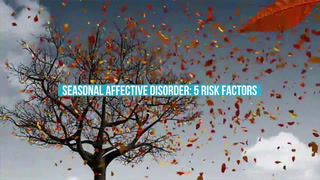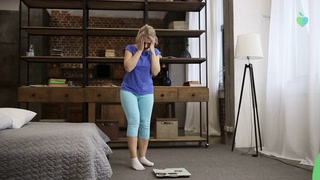The Signs of Seasonal Affective Disorder
Do you begin feeling emotionally overwhelmed as the hours of daylight wane in fall and winter? You may have a form of depression called SAD.


If the changing seasons leave you feeling sad, anxious, “empty,” or you experience other negative emotions for most of the day nearly every day, you may have seasonal affective disorder (SAD) — a condition now officially termed “major depressive disorder with a seasonal pattern.”
Symptoms of this recurrent form of depression most often emerge during the darker winter months, then disappear as days grow longer and brighter come spring, says Ken Duckworth, MD, the chief medical officer for the National Alliance on Mental Illness (NAMI) and an assistant clinical professor at Harvard University Medical School in Boston.
Depression linked to summer can also occur, according to the National Institute of Mental Health (NIMH), but it is much less common than winter episodes of SAD.
RELATED: Summertime Sadness: 11 Ways to Chase Away the Warm-Weather Blues
An estimated 4 to 6 percent of Americans have SAD, according to the American Academy of Family Physicians (AAFP).
Joanna Chodorowska, a personal and sports nutrition coach in North Wales, Pennsylvania, is one of these Americans. Now in her fifties, she’s had SAD since she was in her twenties, when the term was not yet well known. “I recall telling my mother when I was 22 that I had SAD, and she just looked at me like I’d lost my mind,” Chodorowska says.
Seasonal Affective Disorder Risk Factors

Symptoms of Seasonal Affective Disorder
Signs of SAD, according to the AAFP and University of Michigan Health in Ann Arbor, include:
- Weight gain This may be tied to cravings for sweet and starchy comfort foods.
- Fatigue and oversleeping People with SAD feel exhausted even though they may be sleeping a lot more than normal. “With SAD, you eat more and sleep more,” Dr. Duckworth says. “It’s hibernation-like.”
- Difficulty concentrating Small problems can grate or cause intense feelings of nervousness, unease, or worry, which can make it hard to concentrate.
- Social withdrawal People with SAD typically prefer to be alone: They avoid friends and family and don’t participate in social activities they normally enjoy.
- Feelings of hopelessness or guilt People with SAD often feel guilty, worthless, or hopeless.
- Thoughts of self-harm Some people can be so depressed that they have frequent thoughts of death or suicide, says Robert London, MD, a psychiatrist in private practice in New York City and a former clinical assistant professor of psychiatry at NYU Langone Medical Center.
RELATED: Detecting and Diagnosing Depression: It Can Look Different in Men and Women and in Teenagers, Too
Seasonal Affective Disorder: Who’s at Risk
According to the NIMH, risk factors for SAD include:
- Being female Women are much more likely to receive a diagnosis of SAD than men.
- Living far from the equator The further north of the equator you live, the higher your risk.
- Family history If someone in your family has depression you may be more likely to experience SAD.
- Depression or bipolar disorder Bipolar disorder and other mental-health conditions can make you more prone to SAD.
- Younger age SAD can happen at any age, but it most often begins between ages 18 and 30, according to the American Psychiatric Association (APA). Children and teens have been diagnosed with the condition as well.
Researchers don’t know why people get SAD, but they have linked it to several potential causes, says the NIMH:
- Serotonin Serotonin is one of the key neurotransmitters (chemical messengers) in the brain regulating mood. People with SAD may have trouble regulating serotonin levels, leading to seasonal imbalances.
- Melatonin The body makes more of this sleep-regulating hormone in the dark; the longer days of winter might lead to overproduction of melatonin, causing sleepiness and lethargy.
- Vitamin D People with SAD may produce less vitamin D, which may be associated with decreased serotonin activity.
Light Therapy for Seasonal Affective Disorder
Unlike other forms of depression, SAD can be treated with light therapy, consisting of regular daily exposure to a light box that simulates high-intensity sunlight. You don’t need a prescription to buy a light box; you may even find out that your doctor’s office has one you can borrow. “Give it a try for a week and see if it works for you,” says Ani Kalayjian, EdD, an adjunct professor of psychology at Columbia University’s Teacher’s College in New York City who specializes in traumatic stress.
The best time to use light therapy is in the morning. “Sit in front of the box in the morning before going to work and give yourself some sunshine,” Dr. Duckworth suggests. Light therapy typically takes about 30 minutes a day, and treatment usually continues on a daily basis from the time of year that symptoms begin — such as in the fall — and lasts throughout the winter months, Dr. London says.
A word of caution: Do not use tanning beds as a treatment for SAD, because they use ultraviolet rays that can be harmful to your eyes and skin.
Dawn simulators, which gradually increase the light in your bedroom during your last 30 minutes of sleep, can also help. In a study published in the Journal of Affective Disorders, Russian researchers found that dawn simulators were as effective for people with mild SAD as light therapy.
If you don’t want to buy either a light box or a dawn simulator, take advantage of natural sunlight. In the afternoon when the sun is at its brightest, go outside for at least 20 minutes, Duckworth says. Also sit near the window when you’re inside, and open the blinds or curtains to let in as much sunshine as possible.
RELATED: 14 Ways to Ease Seasonal Depression
14 Ways to Ease Seasonal Depression
Psychotherapy and Medication for Seasonal Affective Disorder
Getting an accurate diagnosis is a critical part of tackling this condition, and that starts with consulting a medical professional.
“Find a relationship with a clinician who can coach you through this and figure out if it is indeed SAD, or if you do worse at Christmastime because your father died on Christmas Eve, for example,” Duckworth says.
It’s important to note that many studies related to treatment for SAD have limitations, and there are very few studies that compare multiple types of treatments head-to-head to see which one might be best. SAD typically lifts when seasons change, but in some cases it may resolve quicker with certain treatment options.
Talk therapy can help you explore your feelings and figure out how to cope. If you are able to identify your SAD triggers, Duckworth says, you may be able to avoid some of them.
A medical professional can also prescribe antidepressants if necessary. A class of antidepressants known as selective serotonin reuptake inhibitors (SSRIs), a group that includes Prozac (fluoxetine), has been shown to be effective in treating SAD, London says, as has Wellbutrin and other brands of bupropion.
Lifestyle Changes Can Help Relieve Seasonal Affective Disorder
Duckworth recommends a variety of ways to combat this condition.
- Take a trip. “Go to Florida or the Bahamas — someplace south with a lot of sun,” Duckworth suggests. “If you can take a vacation to a sunny climate, it will likely help.”
- Maintain relationships with friends and family. “If you go to church, don’t stop,” Duckworth says. “If your family is a big source of stress, figure out a way to be with them that's not overwhelming to you. Maybe plan longer visits for the summer when you seem to be doing better.”
- Don’t self-medicate. Because SAD usually develops during the winter months, when holiday festivities are in full force, self-medication with alcohol or drugs is tempting. “Alcohol use tends to go up in the winter as people attend more parties,” Duckworth says. “But if you’re using alcohol or drugs to change the depressed way you feel this time of year, it’s probably compounding your problems as opposed to helping them.”
- Take care of your general health. Regular exercise and healthy eating may offer some relief.
Keep in mind that it may take a combination of approaches to manage SAD.
Chodorowska says she’s able to manage her bouts of depression by eating healthy, exercising, and loading up on probiotics and vitamin D. A runner, she tries to exercise outside at least once a day, even when it’s cold and snowy. A friend gave her a light box, which works very well: “I use it for 20 to 30 minutes in the morning when I’m having my coffee,” she says.
RELATED: 5 Fall and Winter Foods for Depression
Resources We Love
Here are some organizations that offer information and support for people with SAD.
National Alliance on Mental Illness
The NAMI HelpLine (800-950-NAMI) offers free peer-to-peer counseling.
National Suicide Prevention Lifeline
The Lifeline (800-273-8255) provides confidential 24/7 help.
Families for Depression Awareness
The nonprofit offers information about mood disorders, finding treatment, and the role of caregivers.
University of Michigan Eisenberg Family Depression Center
The center provides educational materials and fact sheets on SAD.
Depression and Bipolar Support Alliance
The organization offers in-person and online support groups for people living with mood disorders as well as their family and friends.
Additional reporting by Pamela Kaufman.

